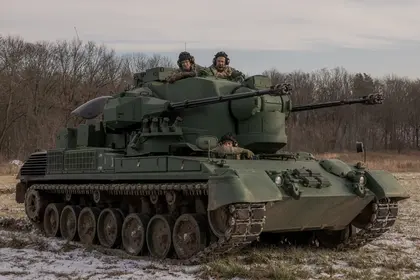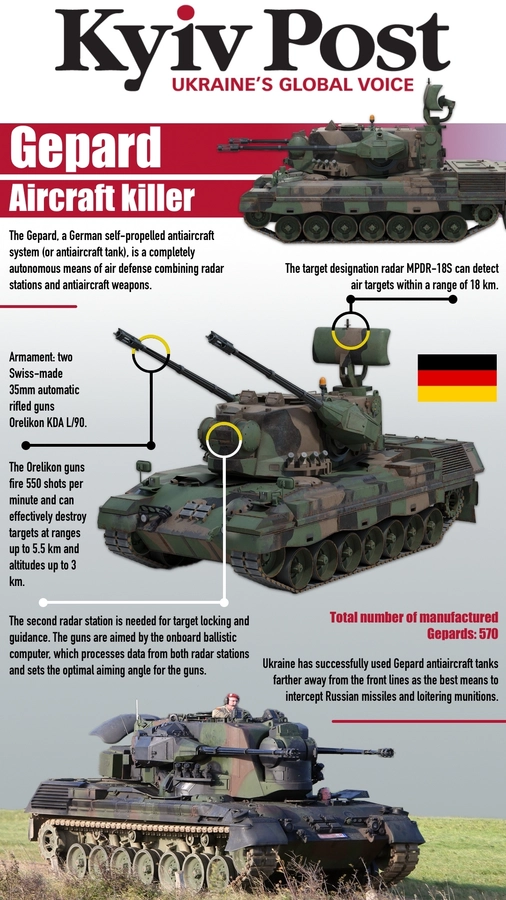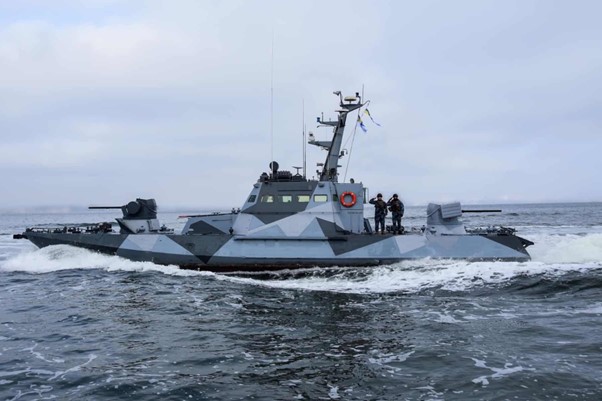The new aid package from Germany announced on Dec. 22 includes three Gepard anti-aircraft guns and 30,000 shells for them. The country also transferred 2,500 155mm artillery shells, two Wisent 1 mine clearance tanks, 10 Vector reconnaissance drones, two border patrol vehicles, and two airborne missile protection systems (AMPS).
What is the Gepard?
JOIN US ON TELEGRAM
Follow our coverage of the war on the @Kyivpost_official.
The Gepard is a German anti-aircraft self-propelled gun, or anti-aircraft tank. It is a completely independent air-defense system, which combines both a radar station and weapons for shooting down targets. In addition, it can independently move and change its location. The German defense company Krauss-Maffei manufactured these machines until 1980. A total of 570 such anti-aircraft tanks were produced.
Development began in 1966, when it became clear that the Bundeswehr could not continue to use the already outdated American M42 Duster guns from the early 1950s. The new system was based on the body of the already existing German tank Leopard 1. The use of the adapted Leopard chassis provided good running and maneuvering characteristics.
In 1969, the design work was completed, and the testing phase began. Four prototypes with 30mm and 35mm guns were produced. Test shootings revealed the advantages of the 35mm version, so in 1973 it was decided to start mass production of this particular modification. The first Gepards entered service with the Bundeswehr in 1976. Between 1976 and 1980, Germany produced 420 such anti-aircraft tanks for its armed forces and delivered 95 units to the Netherlands and 55 to Belgium.

Holocaust Survivor Says Germany Must Help Ukraine
The armament
The Gepard is armed with two Swiss-made 35mm Oerlikon KDA L/90 automatic rifled guns. The total ammunition of 680 rounds – 340 for each gun – can consist of both conventional HEI-T high-explosive incendiary munitions, shells designed to destroy typical air targets such as cruise missiles, helicopters and aircraft, and armor-piercing shells, which can be used on armored ground targets.
Oerlikon KDA guns have a rate of fire of 550 rounds per minute and can effectively destroy both air and ground targets at a distance of up to 5.5 kilometers and at an altitude of up to 3 kilometers. The power of the 35mm automatic cannon is more than enough to turn any air target into a sieve, and if using under-caliber armor-piercing shells, this cannon can effectively destroy even enemy armored personnel carriers and armored vehicles.
Additionally, the Gepard is equipped with four launchers for deploying smoke screens.
Electronics and radars
Over the years of operation, the Gepard underwent several modernizations and updates. Germany decommissioned the iteration developed in the 1960s only in 2012.
In 1985, a laser range finder was installed on the Gepard, and the SEM 25 on-board radio station was replaced with a more advanced one – SEM 90.
During the next upgrade to version 1A2, the Gepard received a new digital ballistic computer.
The Gepard is equipped with two all-weather radar stations. The surveillance radar MPDR-12, located on the roof of the turret, is necessary for finding targets and scanning the airspace within a radius of 15 kilometers. The second radar is necessary to capture the target and guide it. The tracking radar is located in the center of the front part of the turret, between the guns. Both radar stations work independently of each other, each is equipped with mechanisms of protection against radio-electronic countermeasures and built-in self-diagnosis systems.
In the second half of the 1980s, the MPDR-12 was replaced by a newer MPDR-18S radar station, capable of detecting targets at a distance of up to 18 kilometers.
The Gepard, in addition to two radars, has a highly effective fire control system, a precise on-board navigation system and targeting systems that allow high-precision shooting at both air and ground targets. The fire control system automatically calculates the necessary advance for the selected target, taking into account atmospheric pressure, temperature and humidity, as well as wind speed and direction.
This anti-aircraft tank is equipped with a “home-foreign” system that allows it to distinguish domestic aircraft from enemy jets. After the detection radar captures the target, the “home-foreign” system carries out its identification. If it is an enemy aircraft, the tracking radar is activated. The digital ballistic computer carries out aiming guns at the target. It processes the information received from both radars and determines the best angle for aiming the guns.
When the air target is in the striking range, the crew receives a signal to open fire.
Mobility
The Gepard is powered by a 10-cylinder V-shaped multi-fuel four-stroke MTU MB 838 CA-М500 diesel engine. This engine was installed on the Leopard 1. It develops a power of 830 hp, which provides the tank with a specific power of 17.3 hp per ton. If necessary, the engine can run on diesel fuel, jet fuel, gasoline, and their mixtures.
How is the Gepard used?
The Gepard is a weapon from the time when Soviet helicopters and aircraft could theoretically attack Europe at low altitudes. It was designed to cover armored columns and protect important objects.
In Ukraine, Gepards are successfully used mostly to work closer to the rear, because they are excellent for shooting down Russian attack drones and cruise missiles. The Armed Forces of Ukraine use these systems to protect cities and strategic objects.
The Gepard anti-aircraft tank has become an important element of Ukraine’s air defense system due to its ability to easily shoot down Russian Shahed-type attack drones.
Ukrainian mobile air defense groups use Gepards. It is quite effective because the system has two radars searching for air targets. At the moment when the target becomes visible on the radar, its coordinates are transmitted to MANPADS (man-portable air-defense systems) operators, such as the Soviet Igla or the American Stinger. Such cooperation significantly increases the chances of a successful hit.
In modern realities, the use of Gepards on the front won’t be rational, since they are equipped only with automatic guns and do not have anti-aircraft missiles, and the radius of combat operations against air targets is limited to a range of 4,500 meters. This is not enough to fight against Russian helicopters, which have an anti-tank missile launch range of 10,000 meters. In the event of such a confrontation, the Gepard can turn from a predator into a victim.
The Ukrainian army has also faced a shortage of 35mm ammunition for this anti-aircraft tank because the ammunition was developed and produced in Switzerland, which adheres to a strict policy of neutrality. As such, no country has the right to supply new ammunition for Gepards to Ukraine without Switzerland’s permission. And Switzerland has consistently vetoed transfer of its ammunition to Ukraine.
However, German arms manufacturer Rheinmetall came to Ukraine’s rescue by deciding to produce ammunition at its own factories in Germany.
You can also highlight the text and press Ctrl + Enter











